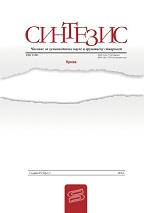Женски акт у опусу Зоре Петровић
The Female Nude in the Oeuvre of Zora Petrović
Author(s): Maja MarkovićSubject(s): Gender Studies
Published by: Центар за хуманистичке науке »Синтезис«
Keywords: female nude; Zora Petrović; women; feminism; patriarchal culture
Summary/Abstract: The thematic scope of Zora Petrović’s paintings mostly comprised female nude paintings and clothed female figures, portraits, self-portraits, still lifes and a negligible number of equally good landscapes. The presence of women in Zora Petrović’s oeuvre through different kinds of representation gives us a possibility to interpret her work in various ways. Zora Petrović was an artist who cultivated and developed an expressionist artistic language arising from strong emotions and materialised by means inevitably forceful, expressive colours. She painted on large canvases, quickly, in wide strokes, making nervous, energetic, broad strokes, with a lot of dense paste, without any subsequent adjustment. In the beginning of her career we can see the influence of Andre Lhote, whose school of painting she attended very briefly during her first, one year study visit to Paris in 1925 and 1926. Lhote’s constructivist approach can be recognised in the paintings Zora Petrović created towards the end of the 1920s (Bathers, 1926). During the 1930s the representation of young women’s bodies, emphasized eroticism, set in a studio enviroment dominated Zora Petrović’s painting (Desire, 1933). The last decade was marked by the creation of her major works with large and massive bodies, which are imprinted in the confined space of the canvas (Green nudes, 1957, Two nudes, 1958). Zora Petrović presented us a woman who shows signs of sadness and happiness, pain, impermanence and aging. Her paintings of fe- male nudes reflect the uncompromising thematisation of female desire and sexuality within a culture in which sexual desire is exclusevely coded as male. Her paintings represent radical re-examination of the social norms of hetero- sexual and patriarchal society, as well as questioning the ways the woman was produced as a category and the method that determines her as subordinate, passive, and socially invisible.
Journal: Синтезис - часопис за хуманистичке науке и друштвену стварност
- Issue Year: IV/2012
- Issue No: 1
- Page Range: 175-190
- Page Count: 16
- Language: Serbian

